“So how does soap work?”
To answer this lets first clarify what soap technically is. Not all products that appear to be soap, or are commonly referred to as a bar of soap are in fact, soap.
To be called soap, the product must be comprised mainly of alkali salts of fatty acids which are formed when fats or oils are combined with an alkali, such as sodium hydroxide/lye. The alkali breaks down the fats or oils and turns it into a solid bar of soap. When properly made no sodium hydroxide is left after the chemical reaction. This is why it’s important to use certified soap as it’s formulation is reviewed to make sure it’s safe. There are very strict laws in the UK and Europe around this.
If the “soap” is not made this way and isn’t made up of slightly alkali salts, then it’s a detergent and not soap. Essentially the cleaning action is usually performed by added chemicals.
So how does real soap work?
The chemistry behind it comes down to the make up of the soap molecules. One end is a polar salt and the other end is a nonpolar fatty acid or hydrocarbon. The polar salt is hydrophilic, or attracted to water. While the nonpolar fatty acid is hydrophobic, or repelled by water but importantly is attracted to fat or oils.
When you wash your hands or anything else for that matter with soap, the soap particles attach to both the water and oils and lift them away from the surface. Whether your skin or a dirty plate…
As already mentioned, real soap is slightly alkali which creates a temporary environment which is not very nice place for bacteria and viruses. Once washed off our skin, it returns to normal which is slightly acidic and full of good bacteria which helps our bodies to naturally fend off the bad bacteria.
We’ll cover the differences between liquid “soap” and soap separately.
Do you have any questions you’d like answered?
Please let us know and we’ll answer them during one of our weekly FAQ Friday posts.



